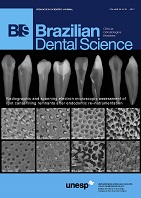Composite resin repairs: What is the most effective protocol?
DOI:
https://doi.org/10.14295/bds.2017.v20i1.1375Resumo
Objective: The objective of this study was to evaluate the combination effect of surface treatments and bonding agents on bond strength of repairs on aged composite resin. Materials and Methods: One hundred twenty microhybrid composite units (Filtek Z250) aged in distilled at 37ºC water for six months were submitted to different surface treatment prior to resin repairs. Ten specimens were randomly divided into 12 groups: non-treated/no bonding agent (negative control), sandblasting /no bonding agent, silane/no bonding agent, non-treated/ etch-and-rinse; non-treated/one-step self-etch; non-treated/ two-step self-etch; sandblasting/etch-and-rinse; sandblasting/one-step self-etch; sandblasting/two-step self-etch; silane coupling agent/etch-and-rinse; silane coupling agent/ one-step self-etch; silane coupling agent/two-step self-etch. Microshear testing was performed to bond strength assessment. Results: Two-way ANOVA and Tukey’s test (?=0.05) demonstrated significant difference between the surface treatments and adhesive systems. Only no treated surface/etch-and-rinse group showed lower bond strength values when compared to other groups. Conclusion: The considered surface treatments were capable to increase the effectiveness of the repair in composite resin when using the adhesive etch-and-rinse.Downloads
Downloads
Publicado
Como Citar
Edição
Seção
Licença
TRANSFERÊNCIA DE DIREITOS AUTORAIS E DECLARAÇÃO DE RESPONSABILIDADE
Toda a propriedade de direitos autorais do artigo "____________________________________________________________________" é transferido do autor(es) para a CIÊNCIA ODONTOLÓGICA BRASILEIRA, no caso do trabalho ser publicado. O artigo não foi publicado em outro lugar e não foi submetido simultaneamente para publicação em outra revista.
Vimos por meio deste, atestar que trabalho é original e não apresenta dados manipulados, fraude ou plágio. Fizemos contribuição científica significativa para o estudo e estamos cientes dos dados apresentados e de acordo com a versão final do artigo. Assumimos total responsabilidade pelos aspectos éticos do estudo.
Este texto deve ser impresso e assinado por todos os autores. A versão digitalizada deverá ser apresentada como arquivo suplementar durante o processo de submissão.




























